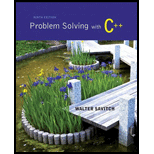
Write a rational number class. This problem will be revisited in Chapter 11, where operator overloading will make the problem much easier. For now we will use member functions add, sub, mul, div, and less that each carry out the operations +, -, *, /, and <. For example, a + b will be written a.add(b), and a < b will be written a.less(b).
Define a class for rational numbers. A rational number is a “ratio-nal” number, composed of two integers with division indicated. The division is not carried out, it is only indicated, as in 1/2, 2/3, 15/32, 65/4, 16/5. You should represent rational numbers by two int values, numerator and denominator.
A principle of abstract data type construction is that constructors must be present to create objects with any legal values. You should provide constructors to make objects out of pairs of int values; this is a constructor with two int parameters. Since every int is also a rational number, as in 2/1 or 17/1, you should provide a constructor with a single int parameter. Provide member functions input and output that take an istream and ostream argument, respectively, and fetch or write rational numbers in the form 2/3 or 37/51 to or from the keyboard (and to or from a file). Provide member functions add, sub, mul, and div that return a rational value. Provide a function less that returns a bool value. These functions should do the operation suggested by the name. Provide a member function neg that has no parameters and returns the negative of the calling object.
Provide a main function that thoroughly tests your class implementation.
The following formulas will be useful in defining functions.
| a/b + c/d = (a * d + b * c) / (b * d) a/b − c/d = (a * d − b * c) / (b * d) (a/b) * (c/d) = (a * c) / (b * d) (a/b) / (c/d) = (a * d) / (c * b) −(a/b) = (−a/b) (a/b) < (c/d) means (a * d) < (c * b) (a/b) == (c/d) means (a * d) == (c * b) |
Let any sign be carried by the numerator; keep the denominator positive.
Trending nowThis is a popular solution!

Chapter 10 Solutions
Problem Solving with C++ (9th Edition)
Additional Engineering Textbook Solutions
Degarmo's Materials And Processes In Manufacturing
Concepts Of Programming Languages
Starting Out with Java: From Control Structures through Objects (7th Edition) (What's New in Computer Science)
Introduction To Programming Using Visual Basic (11th Edition)
HEAT+MASS TRANSFER:FUND.+APPL.
Web Development and Design Foundations with HTML5 (8th Edition)
 C++ Programming: From Problem Analysis to Program...Computer ScienceISBN:9781337102087Author:D. S. MalikPublisher:Cengage Learning
C++ Programming: From Problem Analysis to Program...Computer ScienceISBN:9781337102087Author:D. S. MalikPublisher:Cengage Learning C++ for Engineers and ScientistsComputer ScienceISBN:9781133187844Author:Bronson, Gary J.Publisher:Course Technology Ptr
C++ for Engineers and ScientistsComputer ScienceISBN:9781133187844Author:Bronson, Gary J.Publisher:Course Technology Ptr EBK JAVA PROGRAMMINGComputer ScienceISBN:9781337671385Author:FARRELLPublisher:CENGAGE LEARNING - CONSIGNMENT
EBK JAVA PROGRAMMINGComputer ScienceISBN:9781337671385Author:FARRELLPublisher:CENGAGE LEARNING - CONSIGNMENT Microsoft Visual C#Computer ScienceISBN:9781337102100Author:Joyce, Farrell.Publisher:Cengage Learning,
Microsoft Visual C#Computer ScienceISBN:9781337102100Author:Joyce, Farrell.Publisher:Cengage Learning,



